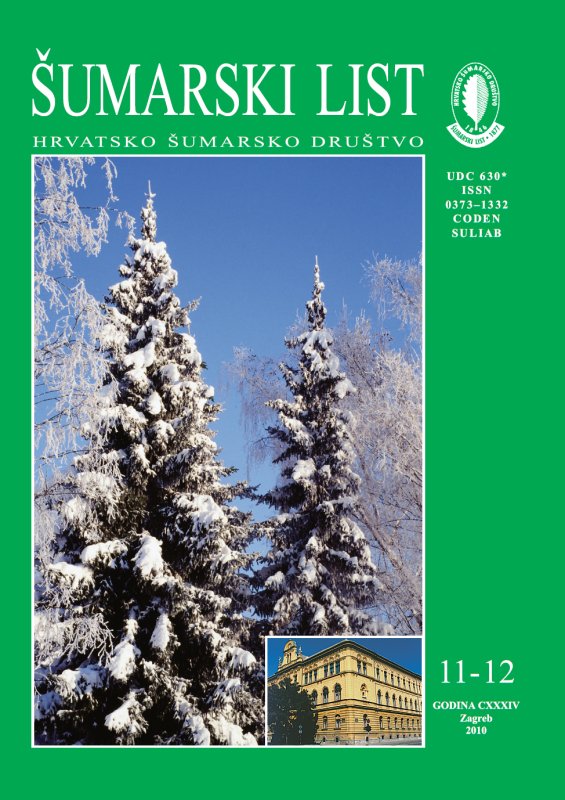
broj: 11-12/2010
pdf (7,55 MB) |
|
||||||||||||||
| RIJEČ GLAVNOGA UREDNIKA | ||
| Branimir Prpić | ||
| AT THE END OF THE YEAR pdf HR EN | 557 | |
| IZVORNI ZNANSTVENI ČLANCI | ||
| Vukelić, J., A. Alegro, V. Šegota, I. Šapić | UDK 630* 188 + 174.7 (001) | |
| Nomenclatural-Phytocoenological revision of the Association Calamagrostio variae-Piceetum dinaricum Bertović 1975, nom. illeg. in Croatia pdf HR EN | 559 | |
| Zebec, M., M. Idžojtić, I. Poljak, I. Mihaldinec | UDK 630* 164 (001) | |
| The Variability of Field Elm (Ulmus minor Mill. sensu latissimo) in Croatian Drava River Valley According to the Leaf Morphology pdf HR EN | 569 | |
| Summary: Due to the Dutch elm disease elms (Ulmus L.) have been categorized as a threatened genus within European flora, so that the protection of their genetic resources has been set as the main goal of many multilateral European projects. Due to exceptional sensitivity to the Dutch elm disease, as well as the high variability of morphological features, special emphasis in these studies has been put on the research of morphological and genetic variability of the European field elm, as well as the delimitation of species within U. minor Mill. sensu latissimo complex. The taxonomic structure of this complex, despite very intensive research, including combining of morphometric and molecular-biological methods, still represents an unknown. In Croatia, the field elm appears in very different ecological conditions, and it is assumed that populations, especially the ones from climatically contrasting and geographically remote stands, differ from each other. Croatian Drava River valley is a place of exceptional natural value and very high biological and landscape diversity. This area is protected by law by establishing Regional Park Mura-Drava, which is a part of the future MuraDrava-Danube Biosphere Reserve. Along the Drava River banks, numeruos anthropogenic activities took place (gas and oil exploitation, hydroelectric power plants, hydroregulation by building of dams and canals, excavating of sand and gravel from river bed). These activities resulted in changes in water relations and caused tree dieback in lowland forest ecosystems, which had drastic negative impact on biodiversity of this area. As a consequence of above mentioned activities, the field elm (Ulmus minor Mill. sensu latissimo) is threatened twofold. First - by negative human impact and second – by Dutch elm disease. Therefore, in this study the variability of five field elm populations (Ulmus minor Mill. sensu latissimo) from Drava River valley, Northwest Croatia has been researched: Banov Brod, Gotalovo, Svibovica, Varaždin and Veliko Polje (Figure 1). Morphometric research of the intra- and interpopulational variability was done on the basis of 10 morphological leaf traits (Figure 2). Descriptive statistics and multivariate methods were used. It was concluded that the analysed morphological traits were very variable. The variability coefficient for populations in total varied from 17,63 % for number of primary teeth in the subapical region to 52,94 % for the leaf base asymmetry (Table 1). There were significant differences among trees within populations and among populations for all measured leaf traits (Tables 2 and 3), except for two traits on populational level: leaf blade length, measured along the shorter side of lamina, starting from the leaf base to the point of maximum leaf breadth (PMPW) and leaf blade width at 90 % of leaf blade length, measured along the shorter side of lamina (PW2). Intrapopulational variability was higher than the interpopulational one (Table 4), except for the following traits: number of secondary and tertiary veins in the subapical region of the leaf (NPSV) and petiole length (PL). According to the results of discriminant and cluster analysis (Tables 5 and 6, Figures 3 and 4), the most similar populations were Svibovica, Gotalovo and Banov Brod. Populacija Veliko Polje differed from other four populations due to strong negative antropogenic influence on its variability. Differentiation of the northernmost population Varaždin can be explained through its geographical position and specific habitat. The results of this study form an initial base for further research of the field elm in Croatian Drava River valley, where in order to preserve genetic resources of this species, combined morphometric and molecular survey approach is required. Key words: Drava River valley; morphometric variability; Ulmus minor Mill. sensu latissimo | ||
| Cojzer, M., R. Brus | UDK 630* 182 (001) | |
| Species Composition and Successional Pathways on Abandoned Agricultural Land in Haloze pdf HR EN | 581 | |
| PRETHODNO PRIOPĆENJE | ||
| Cetl, V., B. Barišić, I. Šarušić | UDK 630* 582 | |
| Transfer of Cadastral data into the New State Coordinate System HTRS96/TM pdf HR EN | 593 | |
| PREGLEDNI ČLANCI | ||
| Kovácsová, P., M. Antalová | UDK 630* 589 | |
| Precision Forestry – Definition and Technologies pdf HR EN | 603 | |
| Landekić, Matija | UDK 630* 302 + 384 | |
| Organizational Culture and Occupational Safety in the Croatian Forestry Sector pdf HR EN | 613 | |
| Balenović, I., H. Marjanović, M. Benko | UDK 630* 569 + 587 | |
| Application of Aerial Photographs in Forest Management in Croatia pdf HR EN | 623 | |


